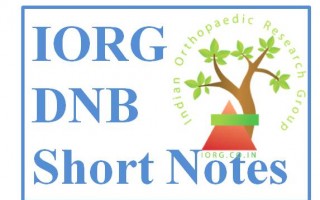BOHLER BRAUN SPLINT (B.B. SPLINT)
It is a common splint used in wards for immobilization and reduction of most lower limb fractures and treatment of other lower limb pathologies.
Structure
It consists of an iron frame with a set of 4 pulleys for application of mobile traction. It is modified from Braun splint which consists of only one pulley for distal tibia or calcaneal skeletal traction. BOhlers Modification: addition of two more pulleys for proximal tibia and distal femur traction.
Uses of 4 pulleys
Lowermost : Tibia and fibular injuries
Second from bottom : supracondylar fracture femur
3rd (directed away from patient) : fracture shaft femur middle third
4th (topmost and directed towards the patient) : prevents foot drop
Uses
With traction
For lower limb injuries with displacement / fragment overlap. The skeletal fraction is given via a K wire, Steinmam pin, Bohler's pin, etc.
In leg fracture : pin through calcaneal tuberosity
In femur fracture : pin through tibial tuberosity in adults, just above condyles in children
Without traction
Compound fracture with no overlap - for dressing and wound cafe and possible immobilization
Soft tissue injury to leg
Rest in case of cellulitis, gangrene, amputation, etc.
Advantages
Mobile traction – especially useful in cases where transportation is necessary as the thraction unit I self contained
Limb in comfortable position
Wound care possible
Multipurpose application
Angle of traction can be changed by changing the pulleys [no change in arrangement required
Simultaneous traction through Calcaneal/diatal tibia and proximal tibia/distal femur can be given
Disadvantages & complications
Non ambulatory
Stiffness / contracture
Urination and defecation becomes difficult
Common peroneal nerve compression
Other complications of recumbancy like bed sore, hypostatic pneumonia etc
What Precautions or regular monitoring is needed for patient in traction?
5 P’s – Pulse/pins and needle; Pressure sores; pintract infection; Physiotherapy; Portable radiographs
1. Pulse and pins and needles - Distal Neurovascular status – sensations, distal pulsation, nailbed circulation, pain on passive dorsiflexion [sign of compartment syndrome]
2. pressure sores – heel, ischium and other pressure areas
3. Pin tract Infection – detect early signs like pain, swelling, redness, discharge.
4.Physiotherapy – ankle mobilization to prevent equinus, anti foot drop spilnt at nights. Knee and other joints mobilized if possible. Static quadriceps to be encouraged
5. Portable radiograph – biweekly or as and when required in first 2 weeks and then weekly. Accordingly arrange the weight and direction of traction.
Tips and Tricks
1. Pressure from slings, wrappings, etc. or from the leg lying against the side of the frame can cause peroneal nerve damage. Make sure leg is not externally rotated, and check the neurovascular status every two hours
2. Make sure the proximal end of the frame does not press into the perineum. A large dressing or pieces of sheep skin can be used to pad this area and can be easily changed if soiled.
3. Make sure elastic bandages are not tighter at the proximal rather than the distal end of the femur or lower leg, otherwise swelling may occur [in skin traction]
4. Usually, the patient can turn towards the splint for backcare, linen changes, etc. It may be easier if the bed is made with two folded sheets, one at the head and another at the foot underneath the splint. Then, if only one part of the bed needs changing, the splint will not have to be moved.
5. if possible apply an anti-embolism stocking to the unaffected leg
6. Passive mobilization of Patella to prevent patella femoral adhesions
7. chest physiotherapy to prevent lung complications
8. In cases of supracondylar fractures of femur, provide support/padding at the fracture site to prevent angulation and avoid padding at the knee joint which might contribute to angulation.
References:
http://www.meditreatments.com/procedure/bohler-braun-splint.html
http://www.zimmer.com/web/enUS/pdf/200080500_TractionHandbook.pdf













 India-Orth
India-Orth